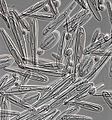Cnida facts for kids
A cnidocyte is a special kind of cell found in animals like corals, sea anemones, hydras, and jellyfish. These animals belong to a group called Cnidaria. Cnidocytes are like tiny, explosive harpoons! They help these animals catch food and protect themselves from predators.
Even though cnidarians often stay in one place and don't have bones, they can still hunt animals like fish and crabs. A cnidocyte shoots out a tiny structure called a cnidocyst (also known as a cnida or nematocyst). This structure contains a toxin that can sting and paralyze prey. This is why jellyfish stings hurt!
There are three main types of cnidocysts, and some animals might have more than one type:
- Nematocyst: This is the most common type. It's like a tiny harpoon that shoots out to hold and paralyze small prey. All Anthozoa (like sea anemones and corals) have these.
- Ptychocyst: This type releases a sticky substance. It helps the animal hold onto prey. It's also used by burrowing tube anemones to build their homes.
- Spirocyst: This one is like a lasso! It shoots out a long, sticky string that wraps around prey.
The cell that makes the cnidocyst is called a cnidocyte, cnidoblast, or nematocyte. It's a very specialized cell, meaning it's designed for just one job. Each of these cells has a hollow, coiled thread inside. On the outside, there's a tiny, hair-like trigger. When something touches this trigger, the cnidocyst fires out like a harpoon in a flash – it takes less than a blink of an eye! The hollow thread goes into the prey, and then a special neurotoxin (a type of poison) is injected. This poison quickly makes the prey unable to move, so the cnidarian can then eat it.
Amazing Sea Slugs
Some types of sea slugs, like the nudibranch aeolids, have a cool trick! They can eat jellyfish and then store the nematocysts from the jellyfish in their own bodies. They keep these stinging cells at the tips of their body parts called cerata. It's like they're borrowing the jellyfish's weapons for their own defense!
How Strong are Nematocysts?
Nematocysts are very powerful tiny weapons. Just one nematocyst can be enough to paralyze a small insect larva.
Some of the most dangerous cnidocytes for humans are found on box jellyfish. One type, the sea wasp (Chironex fleckeri), is known as one of the most venomous marine animals. Its sting can cause extreme pain and can be very dangerous.
Other cnidarians, like the Portuguese man o' war (sometimes called "Bluebottle"), can also cause very painful stings.
The venom from animals like cnidarians might not be very strong for humans, but it can be very powerful against the animals they usually hunt or the predators that try to eat them. Scientists are even studying these venoms to create new medicines and natural insect killers.
Images for kids
-
Nematocysts from the Chironex fleckeri (box jellyfish), magnified 400 times.
See also
 In Spanish: Cnidoblasto para niños
In Spanish: Cnidoblasto para niños





